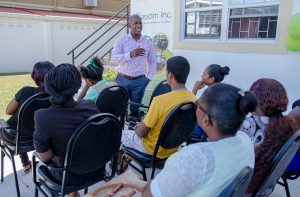…communication between child, parent essential for healthy healing process
IN commemoration of Child Protection Week, the Blossom Incorporated, on Tuesday, held a parenting education session on child sexual abuse at its Nandy Park, East Bank Demerara location.
Dr. Astell Collins, who delivered the keynote address, said abuse is not just psychical or sexual. “Sexual abuse has its own connotation of stain and it’s very damaging beyond that verbal abuse is prominent in child and parent relationships,” Dr. Collins explained.
He added that parents should examine how they communicate with their children. “The world out there is harsh, it’s rough, it’s tough and it beats us down, so when we get home we want to let go and we usually let go on the people we love.”

Dr. Collins also highlighted the importance of father’s involvement in a child’s life, noting that their absence has become an epidemic in Guyana as they are too many ‘daddy-less daughters’ and ‘father-less sons’.
“If there is building with no windows or doors, the building would not be condemned; if the roof is leaking, the building would not be condemned but if there is a crack in the foundation, the building will be condemned and that is what the father represents, the foundation for the family,” he stated.
He noted that at Blossom Inc., parents and others are given the opportunity to create and mold citizens to make a contribution to Guyana.
The Blossom Inc. was created in late 2014 to assist the Guyana Police Force and Childcare & Protection Agency with sensitive cases of child abuse.
Ayo Dalgety-Dean, a family therapist and Managing Director of Blossom Inc., who also spoke at the gathering, said the organisation specialises in forensic interview and therapeutic counselling so that children who have suffered from trauma can begin a healthy healing process.
Dalgety-Dean explained that the organisation offers outreach sessions where staff members would go around the country and hold education sessions on child sexual abuse and violence, where they would educate persons on what are the signs and symptoms to look for and how to respond to a child who made a report.



.jpg)








